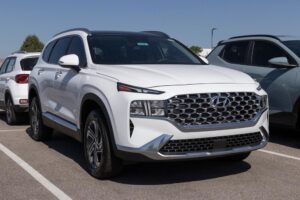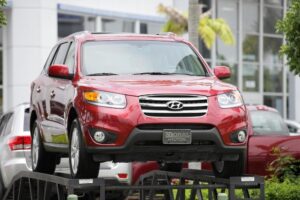Hyundai Santa Fe is a mid-size SUV that offers much value. It has an impressive array of standard and safety features, making it a great SUV.
Not only that, but the SUV has a dashing look. The contemporary design will surely turn heads wherever you go.
Although it might be a solid vehicle, Santa Fe is not perfect. It has its list of issues, which have caused many headaches for many people.
One of those problems is related to SUV not starting. Many people have been frustrated and wonder, “Why won’t my Hyundai Santa Fe start?”. Fortunately for you, I have the answer.
The bad news is, there is more than one reason:
- Weak Battery
- Corrosion On The Terminals
- Faulty Spark Plugs
- Rodent Damage
- Clogged Fuel Filter
Some of these reasons may seem scary to read but don’t worry; they are fixable. All you need to do is read through this article and ensure you don’t miss out on anything.
Table of Contents
- 1 What Would Cause A Hyundai Santa Fe To Not Start?
- 2 Frequently Asked Questions
- 2.1 Q1. Why Won’t My Hyundai Santa Fe Start With New Battery?
- 2.2 Q2. Why Won’t My Hyundai Santa Fe Start Even With A Jump?
- 2.3 Q3. Why Won’t My Hyundai Santa Fe Start But Lights Work?
- 2.4 Q4. Why Won’t My Hyundai Santa Fe Start But Cranks?
- 2.5 Q5. Why Won’t My Hyundai Santa Fe Start Just Clicks?
- 2.6 Q6. Why Won’t My Hyundai Santa Fe Start In The Cold Weather?
- 2.7 Q7. Why Won’t My Hyundai Santa Fe Start After I Get Gas?
- 2.8 Q8. Why Won’t My Hyundai Santa Fe Start But Radio Works?
- 3 Conclusion
What Would Cause A Hyundai Santa Fe To Not Start?

I know you might be worried about your Hyundai Santa Fe having some starting issues.
Take a deep breath and read through this section, and you will find the source of the issue soon.
1: Weak Battery
A weak battery can be one of the biggest causes when it comes to starting problems.
If the battery is weak, it may not be able to supply enough power to the starter motor or fuel pump to get your vehicle started.
You can check if this is the case by using a voltage meter to measure the voltage of your battery.
If it has less than 12 volts, it either means that the battery is low on charge or it is close to its lifespan.
A low charge on the Hyundai Santa Fe’s battery can occur for two reasons.
Either you could have left the lights turned on overnight, or it could be that the alternator has become faulty. The latter has a reduced chance of occurring.
What Should You Do About It?
- If your Hyundai Santa Fe refuses to start up, you should try starting it after connecting a battery charger to it and letting it charge overnight.
- This normally does the trick for weak batteries.
- If you are in a hurry and have a set of jumper cables, you can attach your battery to another car’s battery.
- This will allow you to jump the engine, so it can be started.
- But if your specific unit is too far gone, you must consider replacing it.
- This is normal for a battery, and you need to make sure you buy one that is reliable and tested.
- I would suggest settling for an AGM one, as it does not require any maintenance and is also pretty reliable.
2: Corrosion On The Terminals
A few things can go wrong with your Hyundai Santa Fe battery, but one of the easiest and most common is corrosion on the terminals.
Corrosion is caused when the vapor, produced by the chemical reactions inside the battery, settles and condenses on the terminals.
The issue does not occur suddenly but grows over time to the point that it can cause starting issues with your Santa Fe.
Corrosion on the terminals will prevent your SUV from starting because it acts as an insulator between the battery and the car’s electrical system.
It prohibits the normal flow of current, resulting in the starter motor being unable to turn over the engine and not starting.
What Should You Do About It?
- If you notice corrosion on your Hyundai Santa Fe terminals, you should remove them and clean them with sandpaper or vinegar and baking soda solution.
- Let me tell you exactly how this works. The vinegar and baking soda solution will loosen and break up the corrosion.
- This, itself, will not solve the issue. Now, when you use a sand brush, it will easily clear up the corrosion.
- In some cases, the corrosion is too dense, and such solutions simply are not enough to fix it.
- In those cases, the only viable solution is to replace the battery entirely.
- Preventative steps can be taken with the new battery, but the best way is to check up on the terminals every few months.
3: Faulty Spark Plugs
The spark plugs are an integral part of your car’s engine, and if they’re not working properly, it can cause your Hyundai Santa Fe to be difficult to start.
The spark plugs are responsible for igniting the fuel in your engine and getting it running.
If they are damaged or malfunctioning, your engine will have trouble firing up and running smoothly.
They have a limited lifespan, and the average mileage to replace them is around 60,000 miles. After they have been driven this much, they can be prone to failure.
This can result in your Santa Fe stopping in the middle of the road. That is incredibly dangerous, as it could result in a serious head-on collision.
What Should You Do About It?
- If you’ve determined that your Hyundai Santa Fe problem stems from faulty spark plugs, it’s important to know what type of replacement spark plug will work best with your engine.
- When replacing spark plugs in a Hyundai Santa Fe, ensure they are either platinum or iridium ones; avoid copper and silver plugs as these tend to wear out fast.
- The difference in lifespan between the types of spark plugs is massive.
- The high-end ones can even last for more than 100000 miles, while low-quality ones may not even be able to cross the 30000-mile barrier.
- So, investing more and getting high-quality spark plugs for your Santa Fe is recommended.
4: Rodent Damage
Rodents chewing wiring is a common problem with Hyundai Santa Fe vehicles.
Even though the wiring is protected by plastic sheathing, rodents can chew through it to reach the wires and cause electrical issues in your vehicle.
Rodents can get easy access to the electrical system of the SUV. In reality, manufacturers have not planned for this possibility, so there are clear openings from the bottom of the vehicle.
They can get in and wreak havoc on the electrical system or other systems of the car. Starting problems are one of the many issues that can occur with a rodent infestation.
There can be electrical fires or other failures. Regardless, this issue is extremely serious, and rectifying it is usually not cheap.
What Should You Do About It?
- If you suspect rodents are chewing on your Hyundai Santa Fe wiring, then it’s time to take action.
- First, try using a rodent repellent spray in and around your SUV. This will help deter the little critters from coming back into the car and chewing on anything else.
- If the damage is already done, it’s time to call a professional mechanic who can find out if there is an issue with the wiring and make any necessary repairs so that you can get back on the road safely again.
- You should take extra care with the new wires as electrical issues can also cause fires, which may render your SUV obsolete.
5: Clogged Fuel Filter
A clogged fuel filter is one of the most common reasons your Hyundai Santa Fe having trouble with starting.
The fuel filter is responsible for keeping dirt and other contaminants out of your engine.
It’s a fine mesh screen that sits between the tank and the engine and constantly cleans fuel as it flows through. When dirt builds up on this screen, it slows down or stops the fuel flow.
The more frequently you drive, the faster dirt will build up on your filter, as you have to fill your tank up more frequently.
Before you ask, yes, this is a common occurrence but is usually seen in older models of vehicles. But it can also occur on newer ones, especially if the fuel being added is not clean.
What Should You Do About It?
- The first step is to determine where your car’s fuel filter is located. In most cases, it will be near the fuel tank.
- Once you know where it is, you can clean or replace it depending on its condition.
- If you’re unsure how to do this yourself, then we recommend taking your vehicle to a repair shop so they can take care of everything for you.
- You can clean it if it is an emergency, but replacement is the recommended solution.
- You can avoid this problem in the future by replacing the filter once every one or two years.
Frequently Asked Questions
Q1. Why Won’t My Hyundai Santa Fe Start With New Battery?

You can test the new battery using a multimeter to measure its voltage.
If it’s not more than 12.5 volts, you’ll need to charge it using an appropriate charger. This should take around 6 to 8 hours.
If it’s more than 12.5 volts, try starting your Hyundai Santa Fe again—but if it still doesn’t turn over, you’ll need to look elsewhere for your problem.
Q2. Why Won’t My Hyundai Santa Fe Start Even With A Jump?
In case, you’re unable to jumpstart your Hyundai Santa Fe and you’ve ruled out other causes, like a dead battery cable or corroded terminals, then there is a good chance that your ignition system may be at fault.
The SUV can turn on for a few minutes without its alternator functioning, so it cannot be the cause of your issue.
Q3. Why Won’t My Hyundai Santa Fe Start But Lights Work?
If you’re having trouble with your Santa Fe’s electrical system, there’s a good chance that it’s because your battery is low on charge.
This can happen when the alternator stops working or the battery is just at the end of its lifespan. This can result in the engine not starting but the lights still working.
Q4. Why Won’t My Hyundai Santa Fe Start But Cranks?
If you’re not able to start your Hyundai Santa Fe, check a few things. The most common cause is failing spark plugs.
Having a low fuel level and no fuel pressure can also result in a cranking sound emitted by the engine. This may be due to a failing fuel pump or clogged fuel filter.
Q5. Why Won’t My Hyundai Santa Fe Start Just Clicks?
Clicking sound from the engine while attempting to start your Hyundai Santa Fe could indicate a dead battery.
If you have a multimeter, you can test it by placing the positive probe on the positive terminal and putting the negative probe on the ground post.
Lastly, if your battery has less than 12 volts, it must be replaced.
Q6. Why Won’t My Hyundai Santa Fe Start In The Cold Weather?
If you have an older battery that isn’t performing well in cold weather, consider replacing it with a new battery that has been specifically designed for operating in cold temperatures.
You can find these batteries at any auto parts store or online retailer. Make sure it has high cranking amperes.
Q7. Why Won’t My Hyundai Santa Fe Start After I Get Gas?
Santa Fe owners sometimes find that their SUV refuses to start after getting gas. The problem is usually due to a clogged fuel filter, which prevents fuel from getting through.
If you think this might be the issue, check your fuel filter and change it if necessary. New filters are pretty cheap and can be found easily.
Q8. Why Won’t My Hyundai Santa Fe Start But Radio Works?
If you are unable to start the engine, but the radio is still functional, the first thing you should check is the fuses.
They could have blown, preventing the electrical system from working as intended.
If that is not the case, then the battery on your Santa Fe may actually be low on charge or close to the end of its lifespan.
Related: What Are The Worst Years For The Hyundai Santa Fe?
Conclusion
If your Hyundai Santa Fe having some starting issues, don’t worry! It may not be as bad as you think.
In this article, I’ve covered most common reasons why your car might refuse to turn over and how to fix them.
Furthermore, if you find yourself in need of help with a dead battery or other automotive issues, don’t hesitate to call a nearby mechanic.
They can help get your SUV running again so that you can get back on the road in no time.
I hope this article clarifies your question, “Why won’t my Hyundai Santa Fe start?”.

I am Tahir Azam, and I have been writing amazing articles for TaxiHack for as long as I can remember. I know everything that is to know when it comes to automobiles and is always on top of industry news and developments. While I am not an expert by any means, I pride myself on knowing the ins and outs of many different problems and, of course, their solutions. The articles on our website are some of the best and well-researched content that you will find, and I spend countless hours making sure this remains to be true. This is why I ask you to take your time out and read some of my articles, especially if you find a topic that resonates with you or is something you are looking into. This way, you will find the perfect mix of information and tips on your desired topic. Learn more about Tahir.


